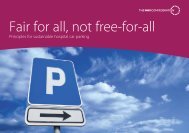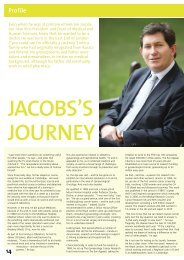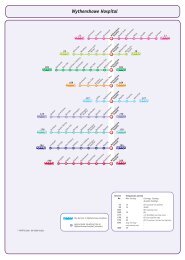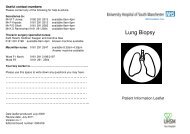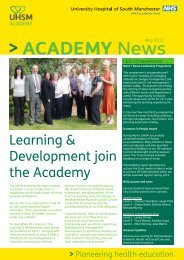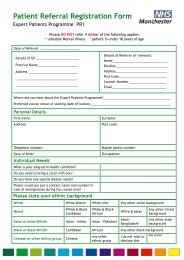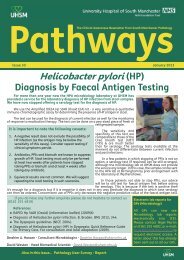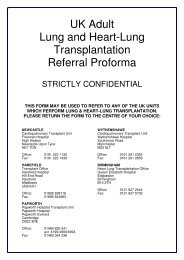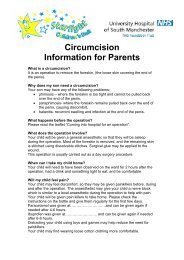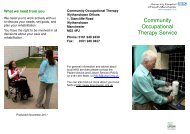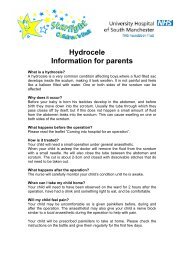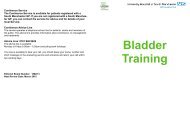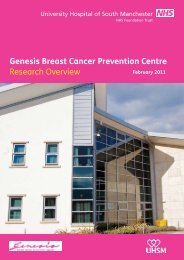A New Beginning 2012-7 - UHSM
A New Beginning 2012-7 - UHSM
A New Beginning 2012-7 - UHSM
You also want an ePaper? Increase the reach of your titles
YUMPU automatically turns print PDFs into web optimized ePapers that Google loves.
What are the risks of valve surgery?<br />
Valve surgery, like any other surgery, carries a risk of complications. The risk of complications<br />
varies for each person and will depend on several factors including:<br />
• your age and sex<br />
• which valve is being operated on, and the extent of valve and heart muscle disease<br />
• whether you are having a coronary artery bypass graft at the same time as your<br />
valve surgery<br />
• whether you have diabetes, lung problems, kidney damage or any significant problems<br />
with the circulation to your brain or legs<br />
• the urgency of the operation.<br />
Your surgeon will take the above factors into account when assessing your individual risk.<br />
Possible complications are:<br />
• wound or chest infection<br />
• ongoing risk of infection (endocarditis). To reduce this risk all patients should have<br />
regular dental checks<br />
• irregular heart beat<br />
• blood clots can form, mostly on mechanical valves<br />
• wear or damage to valves - this is more common with tissue valves<br />
• stroke - there is always a very small risk of stroke with valve surgery.<br />
Consent for your operation<br />
A member of the surgical team will ask you to sign a written consent form for the operation to<br />
be carried out. Your surgeon will discuss the risks, benefits and alternatives for you as an<br />
individual. If you have any questions, please talk to the doctor before you sign the consent form.<br />
What will happen on the day of my operation?<br />
On the day of your operation the anaesthetist will have prescribed for you a ‘premedication’ to<br />
be given a few hours before your operation. This will involve you being given some tablets or an<br />
injection and possibly some of your normal medication. The premedication will help you relax<br />
and may make you drowsy. You will be taken to theatre on your bed.<br />
In the anaesthetic room the anaesthetist will put a drip into the back of your hand and give you<br />
the anaesthetic injection. Whilst you are asleep the anaesthetist will put a tube down your throat,<br />
into your windpipe and connect you to a ventilator (breathing machine). This tube stays in place<br />
throughout your operation. It is needed because during the operation it is necessary for your<br />
body temperature to be lowered to rest your heart and lungs and allow their function to be taken<br />
over by the “bypass and breathing machine”. Whilst the thought of having this tube in your<br />
windpipe is not pleasant, please remember that you will be asleep and therefore not aware<br />
of its presence.<br />
After your operation you will be transferred into the CTCCU whilst still under the anaesthetic. It is<br />
important for us to monitor your heart rate, breathing and blood pressure. Your sedation will be<br />
reduced once you are stable. The tube in your windpipe will be removed when your lungs are<br />
strong enough for you to breathe properly.<br />
10<br />
Healthy eating<br />
Research has shown that by making changes to your diet you can reduce your risk of recurrent<br />
heart problems.<br />
You should aim to achieve this by:<br />
Fats<br />
• reducing your saturated fat intake<br />
• including omega-3 fats weekly<br />
• having at least five portions of fruit and vegetables per day<br />
• reducing your salt intake<br />
• maintaining a healthy weight<br />
All fats and oils contain a mixture of saturated fats and unsaturated fats in different proportions.<br />
Unsaturated fats are either mono-unsaturated or poly-unsaturated.<br />
Saturated fats<br />
Too much saturated fat causes the level of cholesterol in your blood to increase.<br />
Therefore you should reduce your intake of saturated fat.<br />
Saturated fats are mainly found in:<br />
• butter, lard, suet, ghee, coconut oil, palm oil, and any products made using these, for<br />
example pastry, pies, cakes, biscuits<br />
• fat on meat, processed meats such as sausages, beef burgers, salami, corned beef<br />
• full-fat dairy products such as full-cream milk, cream, cheese, full-fat yogurt<br />
• manufactured foods such as chocolate, mayonnaise, cream substitutes.<br />
Unsaturated fats<br />
As part of a healthy diet you could replace foods that contain saturated fats with foods that<br />
contain unsaturated fats. Unsaturated fats can be good for our hearts.<br />
Some foods that could replace products high in saturated fats include:<br />
• oily fish<br />
• nuts and seeds<br />
• olives and olive oil<br />
• sunflower and rapeseed oil<br />
• avocado.<br />
Trans-fats and hydrogenated fats<br />
These fats are formed during food processing when they are subjected to high temperatures.<br />
They are mainly found in deep fried foods, shop bought cakes, biscuits, confectionery and crisps.<br />
It is important to eat as little trans-fats and hydrogenated fat as possible, because they cause<br />
your blood cholesterol to increase.<br />
43



